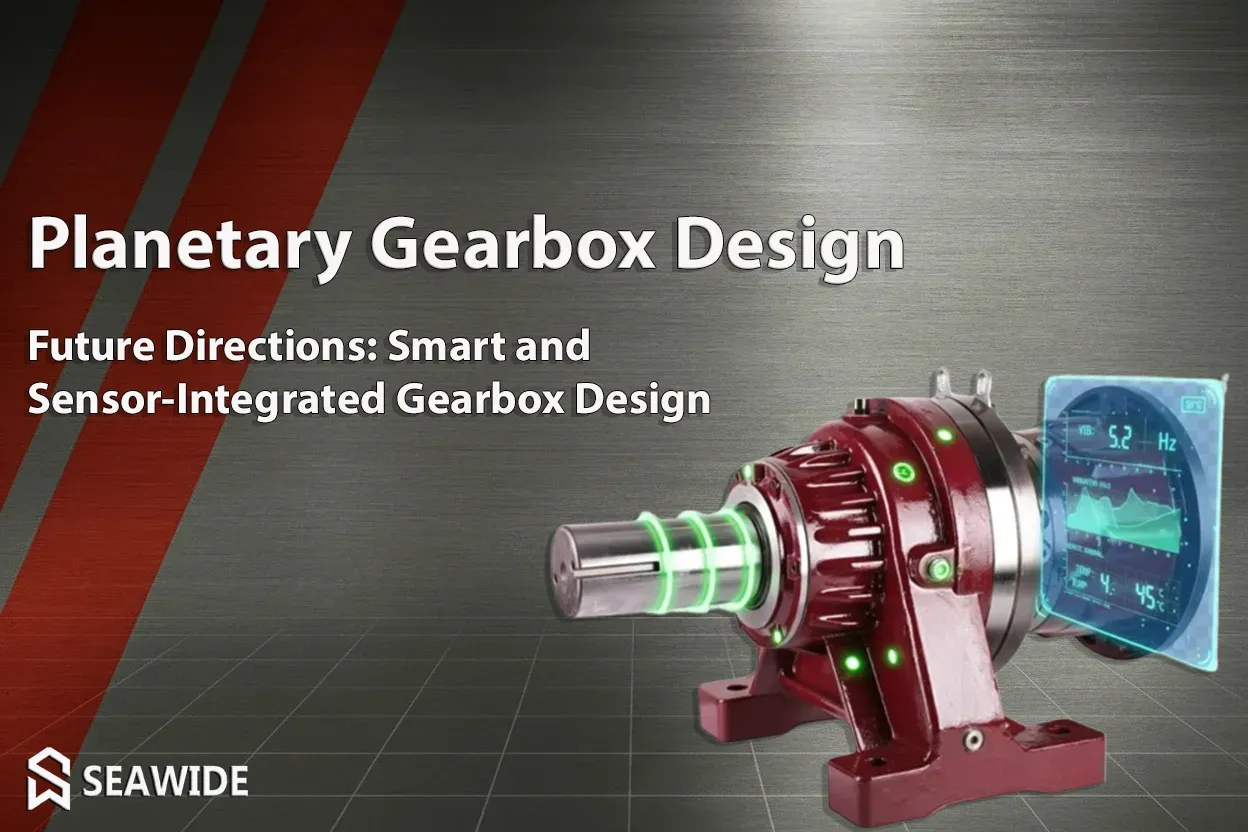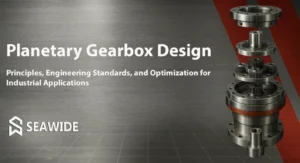Planetary Gearbox Design | Industrial Engineering Standards & Optimization
Introduction to Planetary Gearbox Design
Planetary gearbox design forms the engineering foundation of modern power transmission systems. Unlike conventional reduction drives, a planetary configuration distributes torque across multiple gears—sun, planet, and ring—achieving higher load capacity, compact structure, and superior efficiency.
While numerous gear manufacturers focus solely on production, true mechanical excellence begins in the design stage. The planetary gearbox design determines not only torque handling and backlash but also heat dissipation, lubrication performance, and operational lifespan.
In this article, we explore the science and engineering standards that define reliable planetary gearboxes—and how design precision translates into mechanical performance on an industrial scale.
Core Design Concept: Geometry and Torque Distribution
The core principle of any planetary gearbox design is symmetry. The central sun gear drives multiple planet gears that rotate around it, all enclosed by a static or rotating ring gear. The unique geometric arrangement allows torque to be equally distributed, dramatically reducing stress concentration on individual teeth.
Design optimization begins by calculating gear ratio, module size, and contact stress using AGMA/DIN standards. A higher number of planet gears increases torque capacity but requires stricter alignment tolerances. Finite element analysis (FEA) is used to model tooth engagement, deformation, and bending under peak torque conditions.
Additionally, engineers carefully tune the gear helix angle—balancing smoothness of transmission against axial thrust loads. These geometric parameters are revised through iterative simulation cycles to ensure minimal power loss and maximum mechanical stability.
Material Selection in Planetary Gearbox Design
Design excellence depends on material integrity. The most efficient planetary gearbox design incorporates a mix of hardened alloy steels (42CrMo4 or 20MnCr5) for sun and planet gears, paired with ductile iron housings or carburized steel rings.
Key considerations include:
- Core hardness: ensures gear body toughness during torque spikes.
- Surface hardness: improves wear resistance through carburizing or nitriding.
- Fatigue endurance limit: critical under continuous cyclic loading.
Heat treatment and surface finishing are integral design steps, not post‑processing tasks. These directly affect dimensional accuracy and gear meshing efficiency.
Moreover, advanced planetary gearbox designs in robotics and aerospace now utilize case‑hardened steel with PVD coatings, cutting friction by nearly 20% under high‑precision duty cycles.
Bearing and Shaft Arrangement
When designing planetary gearboxes, bearing selection must align with radial and axial load paths. Common configurations include:
- Tapered roller bearings for industrial torque applications.
- Needle bearings for compact, speed‑intensive systems.
- Cross‑roller bearings where stiffness and alignment precision are crucial.
The bearing layout strongly influences gearbox rigidity, noise level, and heat distribution. Shaft diameters are proportioned based on combined torsional and bending stress, applying safety factors defined by AGMA 6001‑E08 or ISO 281.
Seawide Gear engineers typically incorporate preloaded bearing systems to maintain minimal backlash (< 5 arcmin), ensuring high repeatability in servo or positioning drives.

Explore information and the working principles of Planetary Gearbox design in Wikipedia
Lubrication and Thermal Design
A well‑engineered planetary gearbox design accounts for thermal dynamics from the outset. Lubrication channels, oil ports, and vent systems are not afterthoughts—they form part of the CAD model architecture.
High torque densities generate localized heat around the sun‑planet contact points. To counter this, designers apply Computational Fluid Dynamics (CFD) simulations to study oil flow and temperature gradients.
Choice of lubricant affects friction coefficients, oxidation rates, and seal compatibility:
- Synthetic PAO oils for long‑life, high‑temperature operation (up to 600 °C).
- Lithium‑complex grease for semi‑sealed compact modules.
Effective lubrication regimes extend service intervals and minimize power loss due to viscous drag.
Planetary Gearbox Supplier | Gearbox for Sale & price-SEAWIDE
Housing, Sealing, and Structural Integrity
The external housing of a planetary gearbox is more than containment—it defines alignment accuracy and vibration damping.
Key design features:
- Monolithic housing blocks eliminate assembly tolerance stacking.
- Rib‑reinforced castings enhance rigidity without excessive weight.
- Dual lip seals or labyrinth seals maintain IP65–IP68 protection levels for industrial sites such as mining or marine applications.
Finite Element Analysis validates casing stiffness under dynamic torque peaks, ensuring minimal deflection that could otherwise alter gear meshing angles or bearing preload.
Backlash Control and Precision Engineering
A hallmark of sophisticated planetary gearbox design lies in backlash optimization. Industrial robotics, pick‑and‑place systems, and CNC axes demand backlash values under 5 arcminutes.
Design solutions include:
- Preloaded double‑stage gear arrangements.
- High‑tolerance machining of carrier pins.
- Use of spring‑loaded gear rings or eccentric adjustment systems.
Metrology inspection during prototyping verifies these tolerances, with laser alignment systems used to ensure concentricity of less than 10 µm.
Such precision enables power transmission with near‑zero lost motion—a critical factor in servo accuracy and energy efficiency.

Design Optimization Using Digital Tools
Modern engineering teams employ simulation‑driven workflows for planetary gearbox design.
Tools like ANSYS Mechanical, KISSsoft, and Romax Designer enable predictive modeling across multiple design stages, from 3D solid meshing to fatigue and NVH (Noise–Vibration–Harshness) analysis.
Key benefits:
- Early detection of potential stress hotspots.
- Reduced prototype cycles by 25–30%.
- Validation of efficiency across load spectra.
This digital‑first methodology aligns with Seawide Gear’s engineering philosophy: rapid development, cost reduction, and verified performance before machining begins.
Planetary Gearbox Supplier | Gearbox for Sale & price-SEAWIDE
Modularity and Customization in Planetary Gearbox Design
Industries today require flexible gearbox platforms rather than fixed models. Modular design separates the housing, carrier, and gear stages, allowing rapid gear‑ratio changes or torque scaling.
Seawide Gear’s modular planetary gearbox design approach offers benefits such as:
- Interchangeable ratio sets from 3:1 to 2000:1.
- Compatibility with IEC, NEMA, or custom motor flanges.
- Multi‑stage coupling for high‑torque (up to 1,200,000 Nm) tasks.
This modularity supports diverse sectors—steel, mining, renewable energy, marine propulsion, and bulk material handling—while maintaining uniform quality and cost efficiency.
Testing, Validation, and Compliance
Before mass production, a planetary gearbox design undergoes rigorous testing:
- Torque endurance (up to 1.2 × rated torque).
- Temperature and vibration validation under full duty cycles.
- Noise measurement (≤ 65 dB) for enclosed systems.
- IP rating confirmation to ensure sealing performance.
Compliance with ISO 9001, CE Machinery Directive, and ATEX Zone 2 (for explosive atmospheres) guarantees reliability in critical applications.
Planetary Gearbox Supplier | Gearbox for Sale & price-SEAWIDE
Sustainability and Lifecycle Engineering
Eco‑efficiency is now central to design philosophy. Optimized tooth geometry and low‑loss bearings cut energy consumption by 10–12% compared to earlier gear generations.
Materials are selected for recyclability, and production follows ISO 14001 environmental standards. Extended lubrication intervals reduce waste oil output, lowering overall carbon footprint.
For clients focused on sustainability, modern planetary gearbox designs represent both mechanical strength and environmental responsibility.
Future Directions: Smart and Sensor‑Integrated Gearbox Design
The next stage in planetary gearbox design integrates smart sensors and digital monitoring. Vibration, temperature, and torque sensors can now be embedded within the gearbox casing for real‑time analytics.
This enables:
- Predictive maintenance scheduling through IoT platforms.
- Immediate fault detection and condition‑based service planning.
- Enhanced operational uptime across distributed industrial networks.
Seawide Gear is actively developing smart gearbox modules compatible with Industry 4.0 ecosystems—providing both mechanical performance and digital insight to end users.
Conclusion
Planetary gearbox design is not merely a technical exercise—it is the art of balancing geometry, material science, thermodynamics, and digital optimization. Each parameter, from tooth profile to lubrication flow, defines the reliability and efficiency of the end product.
As industrial systems become more automated and power‑dense, advanced planetary gearbox design will remain the backbone of motion control technology. Through precise engineering, simulation‑driven validation, and sustainable production standards, companies like Seawide Gear deliver uncompromised performance with measurable cost advantages—bridging the gap between traditional mechanics and the smart‑drive future.




